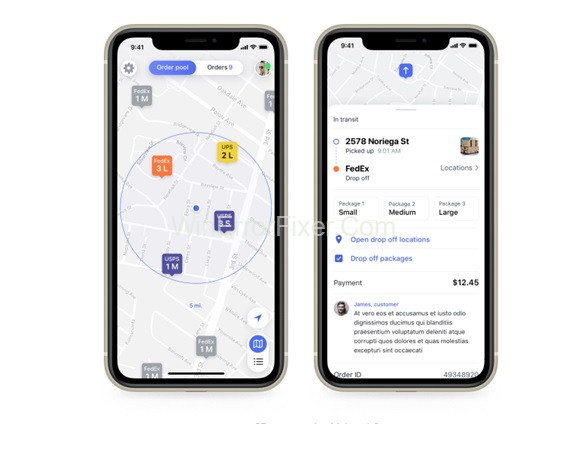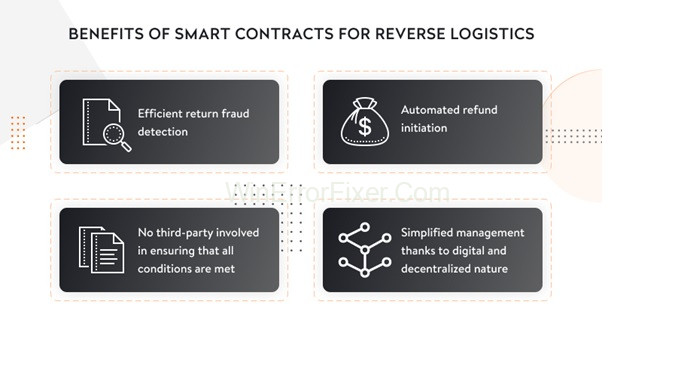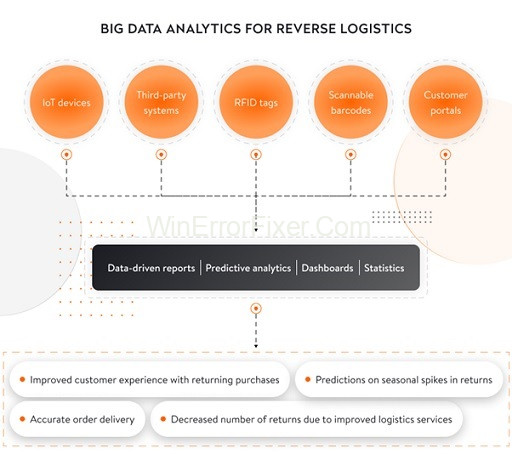Technologies can remove the hassle of reverse logistics, improve relations between a logistics provider and end consumers, and help supply chain businesses pursue principles of circular economy and sustainability.
Return Management Software
Specialized software that allows consumers to return products themselves can save delivery and logistics costs easily. For instance, Re-turns, a reverse logistics software solution our client developed, allows consumers to return packages right from their homes.

A customer simply requests an order pickup in a convenient mobile app and leaves the package for the driver whenever they want. For the driver’s benefit and quicker return pickup, the app is designed to enable drivers to pick up orders on the go, akin to how taxi drivers pick up riders.
The Re-turnz solution also has an anti-fraud system that ensures products are delivered safely. Before registering drivers in Re-turnz, the system verifies their credentials and backgrounds. Besides, a driver can’t mark a parcel as delivered at any location except for an office of the courier service the customer has chosen.
Incorporating such a solution for returns management can relieve consumers from the stress of returning products, thus increasing the chances they’ll order from the same vendor again.
Another example of using return management software was at the 3PL company Sunland Logistics Solutions, which provided a leading retailer with reverse logistics services for sorting, assessing, and allocating returned items received in a warehouse.
As a value-added service, Sunland provided its client with custom return management software (developed by Sunland’s IT partner) that integrated with their client’s existing warehouse management system. This return management software gives Sunland’s clients real-time visibility into the number of returned goods as well as provides an enhanced user experience for customer service representatives who process returns.
Blockchain and Smart Contracts
Distributed ledger technology or blockchain technology is getting popular in many supply chain services. You can find more on the topic in our complete guide on blockchain adoption for logistics.
The Danish logistics company Maersk together with IBM, has developed a TradeLens platform for the blockchain-based supply chain management. This platform is a digital environment for supply chain businesses to collaborate and securely exchange transportation documentation. For instance, TradeLens users can create document dashboards for their shipments and see beforehand which documents or data are missing to prevent failed deliveries or delays.

There are also other ways logistics businesses can take advantage of the blockchain. In particular, smart contract functionality (the digital equivalent of a regular physical contract) written on the Ethereum blockchain finds wide use in the supply chain. Since smart contracts are digital and have a decentralized nature, they don’t require any intermediary (e.g., a lawyer) to compose and manage them.
A smart contract is a secure digital contract built with certain conditions all parties must meet. For instance, a smart contract can initiate a payment to the carrier once the customer receives the order. You can check out other use cases of blockchains in the supply chain industry on the blockchain logistics page of the Yalantis website.
For reverse logistics optimization, smart contracts and the blockchain can be good solutions to identify return scams promptly. Blockchain technology backed up with smart contracts can initiate refunds only after successful verification of a consumer’s purchase history and personal information and after receiving a notice from the logistics company on the condition of the returned product. Unlike manual return management, a smart contract can carefully assess a consumer’s compliance with the retailer’s return policies.
Big Data and Predictive Analytics
Big data analytics helps supply chain companies gain insights into their reverse logistics process. Information retrieved from IoT devices, barcodes, and RFID tags can help logistics operators improve reverse shipment traceability and define the contents of returned packages without opening them.



Warehouse staff can just scan a parcel’s barcode to define the product’s condition and the next step for it (e.g., reselling or recycling). Find out how we’ve developed an efficient big data analytics solution for the US 3PL company.
Plus, once a customer requests a product return, some companies ask them to fill out a short form telling why they’re returning their purchase. These answers can then be used to predict better the number of returns for a certain product type and prepare beforehand for processing these returns.
The ability to analyze raw data from diverse corporate systems, IoT devices, and third-party systems helps data scientists define and predict patterns for optimizing the supply chain in reverse logistics.
For example, 3PL company OceanX offers a wide range of tech-empowered services for its customers (mainly e-commerce and retail companies like Glossier and Mielle). OceanX has developed a Bridge platform that allows its clients to track lots of real-time data associated with order fulfillment, including returns. OceanX clients can find out reasons for returns as well as define trends to make adept changes to their return management services in the future.
Read also: Ensuring IoT-Based Predictive Maintenance for Large Manufacturers
Apart from those mentioned above, there are plenty of technical solutions for reverse logistics that could be integrated as part of transport management or warehouse management systems to tackle those issues that are specific to your business.
Streamlined reverse logistics management can help supply chain companies learn more about their clients and stay on track for continuous improvement. At Yalantis, we are constantly increasing our technical expertise to offer our clients modern and relevant solutions.
If you realize now is the time to automate your reverse logistics workflow, make it hassle-free, and increase its profitability, performance, and efficiency, we’ll help you implement a suitable custom digital solution.



















